This Harold and Maude E-Type hearse replica is way over the top

It was sometime in the mid 1970s in Ann Arbor, Michigan. My girlfriend and I were leaving a student film co-op, having just watched the 1971 dark comedy, Harold and Maude, and I was angry.
I wasn’t angry at my girlfriend, whom I later married. I was angry at Hal Ashby, the director of the movie, which is about a May–December romance between a disaffected, death-obsessed teenage boy and a 79-year-old woman. Before getting together with Maude, played by Ruth Gordon, Harold, played by Bud Cort, vexes his wealthy widowed mother by using a Cadillac hearse to pick up dates she has fixed up for him, then faking suicide. After his mother replaces the coffin Caddy with an E-Type Jaguar roadster, thinking it wouldn’t scare off so many suitors, Harold proceeds to customize the Jaguar to look like a hearse, complete with landau bars. Take away the landau bars and it’s a beautiful E-Type shooting brake. It retained all of the E’s sexy curves, including the rear haunches, and capped them with a classy long roof.
The Jaguar hearse was lovely, but my anger at Ashby stemmed from the film’s final scene the car gets driven over an oceanside cliff. The car goes end over end and smashes, roof first, into the rocky beach below. Ashby freezes the shot with the car in mid-air, before it violently pancakes into the ground. Some say the freeze-frame was Ashby’s way of indicating that he really wrecked the Jaguar, though the director said it was due to not being able to use planned footage from secondary cameras. In fact, the climactic scene almost didn’t make it into the movie at all. A battery of cameras was set up to film the car going over the cliff from a variety of angles, and a launch ramp was built on the cliff top, out of the frame, to give the non-running car enough speed to make it over the cliff. For synchronization purposes, all the cameras were wired to a single switch, which apparently failed to trigger all of them. Realizing that, but also high on cannabis, Ashby panicked and yelled, “Cut!” but it was too late. The Jaguar had already been released down the ramp and was heading to the edge of the cliff. Only two cameras recorded the scene, one taking a long shot from hundreds of yards away from the dive, and another on the beach below the cliff. Ashby felt lucky to have been able to salvage any footage at all, and the result is still pretty dramatic.
In any case, unlike the hundreds of Dodge Chargers used in filming The Dukes of Hazzard tv series or The Italian Job’s Lamborghini Miura there was no stunt double for the Jaguar hearse. While no animals were harmed in the production of Harold and Maude, the lone Jaguar hearse that was made for the movie was indeed injured. Perhaps not injured beyond repair today as would have been the case in 197; nowadays, it’s almost impossible for an E-Type to be beyond restoration. Well, as long as the number plate is still intact.
I was not the only person upset over the destruction of the Harold and Maude Jaguar hearse. Ken Roberts, an eclectic collector, fell in love with that car. And because he’d done okay in the oil and gas exploration business, he had the means to recreate it.
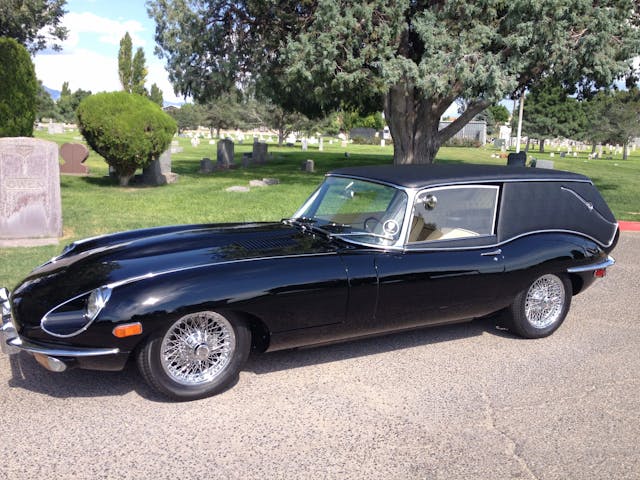
Regarding replicas of movie and television cars, I’m of the opinion that if it makes you smile to dress up your VW Beetle like The Love Bug‘s Herbie, go ahead. Still, the pedant in me cringes when I see a Ghostbusters Ectomobile made out of a 1960 Cadillac professional car, rather than the distinctive, high-finned 1959 model that was used in the original movie. If you’re going to make a replicar, make an accurate and authentic replicar.
Roberts’ recreation ended up being more than authentic. He built the car to a higher level than even the fabricators who made the original movie car. Along the way he was able to document the history of the original build and in doing so give credit to Red Harden, the Riverside, California fabricator who made the car used in the movie. The original vehicle cost the film’s producers about $32,000, which is about $215,000 in 2021 dollars. Recreating film history isn’t cheap. Roberts told Hagerty that the replica cost him multiples of what the original cost, the better part of a million dollars, to build. Tom Smith, of Phoenix, did the metal work, while Chris Hawkins, of Tempe, did the interior.
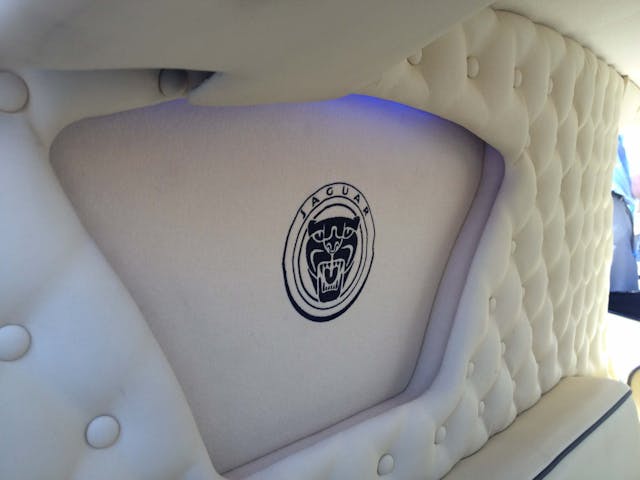
As mentioned, Roberts, now 76, is a man of means from a successful family. His uncle was in the oil and gas exploration business who founded The Masters golf tournament with golfer Bobby Jones. Roberts followed his uncle into the same industry.
Ken’s a lifelong car enthusiast. He and his wife Glenda didn’t just leave their wedding reception in a special limousine, they were actually married in their first Rolls-Royce, a 1955 Silver Dawn. The couple sat in the back seat, their two witnesses sat up front, and the Justice of the Peace stood outside the Rolls while performing the ceremony. The couple are still Rolls enthusiasts. Ken’s daily driver is a late model Phantom that he found with just 8000 miles on the odometer, and he also has a 1987 Corniche convertible. Other cars in Roberts’ collection are a ’34 Mercedes-Benz 500K, a ’57 Chevy convertible with just 175 miles, a Lincoln limousine that stretches to 30 feet, and a restomodded 1958 Corvette with C6 mechanicals that Mrs. Roberts drives. Roberts formerly owned a replica of James Deans’ last Porsche, which Dean nicknamed “Little Bastard,” but he was a bit superstitious about it, wouldn’t drive it, and ended up selling it to an Irish collector who now keeps it in his castle.
Cars aren’t the only things the Roberts have collected. Glenda has owned a stable of champion quarter horses, and their Arizona home includes a full-scale vintage Texaco gas station, a fully-operational railroad-car style 1950s diner, and a second dining room that is formally decorated with oil paintings and crystal chandeliers, doubling as a garage for their Lincoln limo.
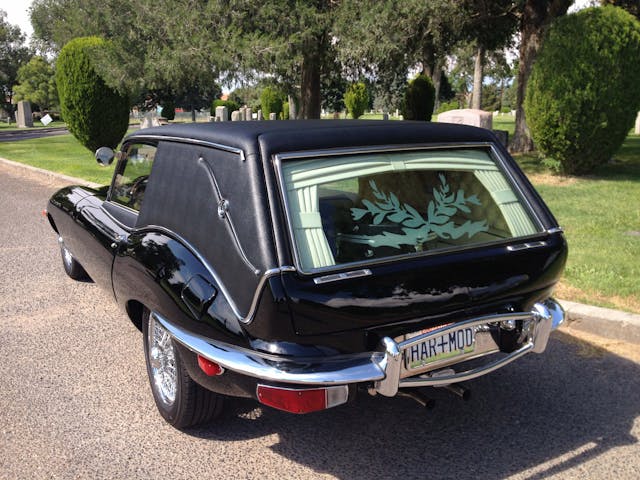
How did Roberts come to make the Harold and Maude Jaguar hearse? It grew out of his friendship with the late George Barris. In 2013, the car enthusiast world was abuzz with the news that Barris had sold the iconic Batmobile he had made for the 1966 Batman television series, crossing the auction block for an astounding $4.2 million dollars. The buzz around the Batmobile got Roberts thinking about owning a movie car. He’d always loved Harold and Maude, the movie, and its Jaguar hearse, so with his boyhood friend Don Kessler he started looking into owning one. Assuming that someone had already made a replica, Roberts and Kessler contacted Jaguar clubs, but it was to no avail. The two decided to replicate Harold’s hearse on their own.
The movie’s plot has the E-Type converted to a hearse in just two days. The actual film car actually took Red Harden six months to fabricate, without knowing exactly what we he was even doing. He was contracted by a European affililiate of the production company that didn’t tell him the project was for a film. According to Roberts, Harden also had a hand in the build of the 1966 Batman TV series Batmobile, as well as being involved in the build of the choppers used in Easy Rider. What took Harden six months to build took Roberts and Kessler four years to replicate. Incompetent and unethical restorers, hired early in the build process, increased the the cost in addition to the time invested.
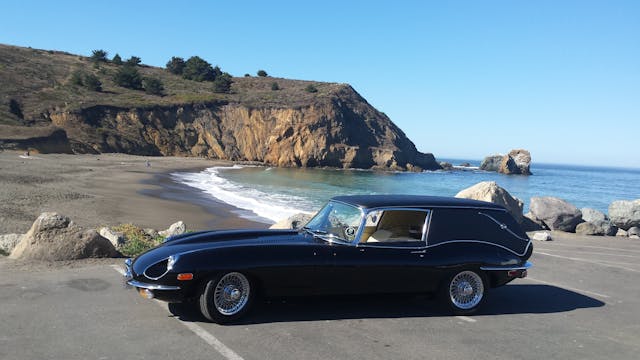
A bit of movie magic got in the way, too, leading Roberts down an unnecessary path. You see, while the movie has the hearse converted from an E-Type roadster, in reality Harden used a 2+2 fastback coupe as the foundation of the build. Not knowing that, Roberts bought a 1970 roadster out of the private collection of a Las Vegas Jaguar dealer. After shipping the car to his Arizona home, Roberts and Kessler started researching the movie car, going frame by frame to determine details. They discovered that Ashby and Paramount used two different Jaguars to make the film. The roadster Harold’s mom gave him was just a prop car, while a ’67 2+2 coupe was used for the actual conversion. The E-Type 2+2 has a wheelbase that is 13 inches longer than the roadster or fixed-head coupe—which makes sense if you’re trying to make a long-roof car.
After buying the wrong Jaguar and then obtaining the correct one for the replica, Roberts had to identify and then locate the car from which the builders sourced that long roof. That turned out to be a Datsun 510 wagon, and obtaining that hard top turned into one of the biggest obstacles of the whole process. At the time the hearse replica build was started, the 510 had been out of production for 40 years. Japanese cars from that era were not particularly rust-resistant, and the few survivors are highly collectible. Wagon versions are particularly rare, and most owners of those wouldn’t want them cannibalized. While Nissan collectors may not be happy with Roberts’ team scavenging that rare roof, Jaguar enthusiasts have embraced the E-Type hearse wholeheartedly. It’s first public showing was in 2017 at the International Jaguar Festival in Scottsdale where it was well received. The Jaguar hearse has also taken a 2nd place at the Jaguar Club of North America nationals, along with multiple Best In Show ribbons at a number of concours d’elegance.
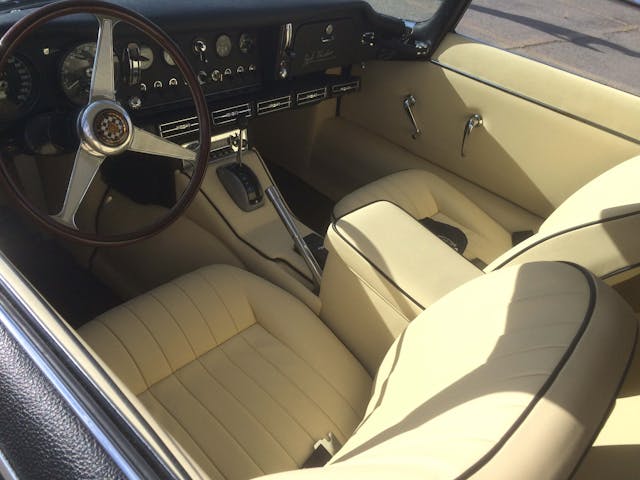
Those ribbons partly recognize that the project is in many ways more “authentic” than the original film car. As there were no scenes in the movie shot inside the Jaguar, the actual Jaguar on screen had a very rudimentary interior, with body panels covered with cork sheets, painted flat black to avoid any unwanted reflections. Chris Hawkins, of Tempe’s V.I.P. Interiors, gave the replica hearse a luxurious interior. The seats are upholstered in ivory colored leather, with contrasting black piping, while the coffin compartment is finished with carpeting and tufted leather side panels, just as you’d find in an actual hearse. The interior’s leather skins were sourced from the same supplier that Rolls-Royce uses. There’s even decorative etching on the rear window, just as the movie car had, similar to what you might see on a vintage hearse. Roberts didn’t know that while the movie car had an apparent rear hatch, that was a prop and could not open. Building a functional hatch cost him a large fraction of the total build cost: about $100,000.
The Jaguar hearse is pretty much stock mechanically, using the classic inline-six-cylinder engine, an automatic transmission, and Jaguar’s stunning wire chrome knock-off wheels. For what it’s worth, at least according to the movie’s soundtrack, that automatic transmission, like the opening hatch, isn’t quite authentic. In the movie, Harold hustles the car up a dirt road leading to the promontory, and you hear him winding up through the gears of what surely sounds like a manual transmission.
Befitting a car whose real-life home is in the American southwest, an underdash air conditioner unit has been fitted. Roberts says that E-Type hearse drives like a dream. In fact, he thinks it’s better balanced than the roadster, due to the roof’s additional weight.
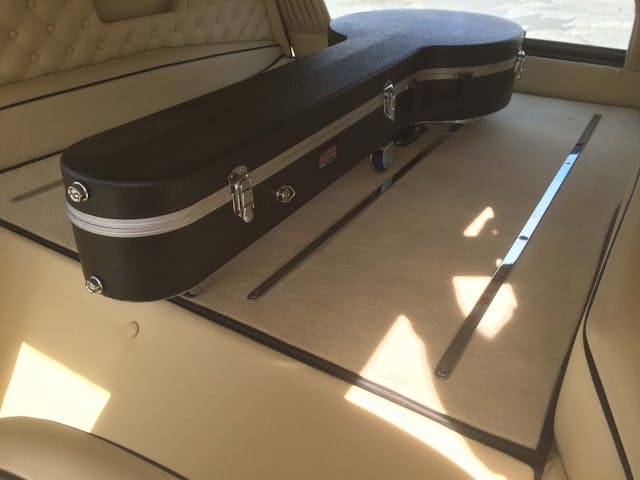
While it’s a beautiful car, in truth it wouldn’t make a very practical hearse, except, perhaps, for a pet cemetery. There’s not enough room in the back for a full-size coffin. Instead, Roberts keeps a custom banjo case back there. In the movie, we’re supposed to think that Harold has joined Maude, taking his own life by driving the Jaguar off the cliff. But after watching the car pancake on the beach, we see Harold walking away from the edge, playing his banjo. Appropriate for a tribute to a theatrical film, Roberts’ Jaguar hearse can put on a show. Activated by remote control, the hatch opens up and out slides the banjo case, which itself opens to reveal, not a banjo, but rather props from Harold’s fake suicide attempts.
Much as Roberts loves the Harold and Maude Jaguar, he’d consider seeing it go to a new home if the price were right. The Roberts’ have decided to downsize their collection and indulge another of their passions: travel.
Although the movie is a comedy, suicide is a serious issue. The National Suicide Prevention Hotline is 800-273-8255 (800-273-TALK).


Where is the car now?